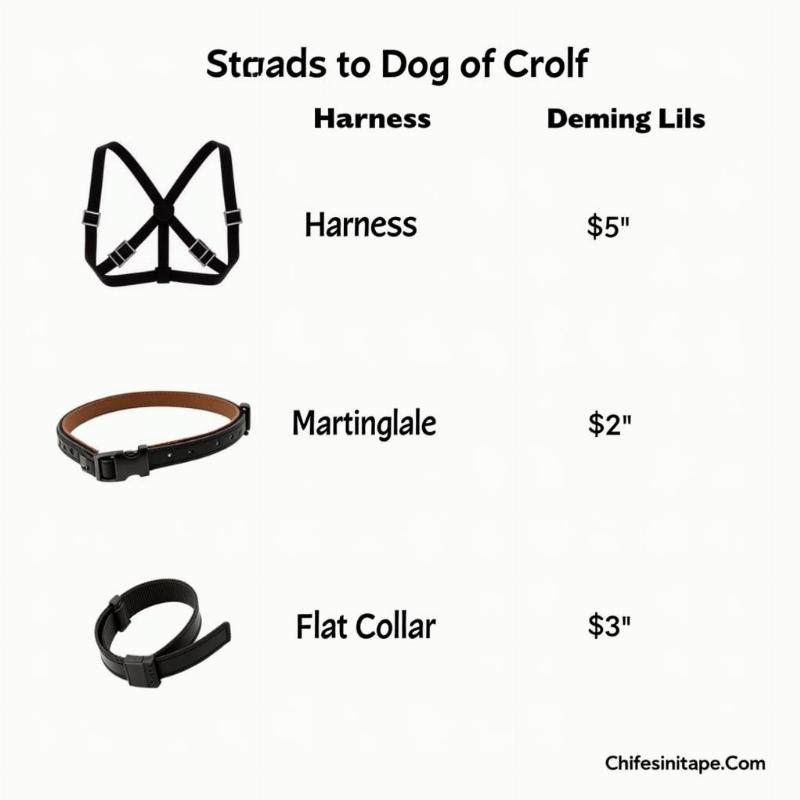Slip on collars, also known as slip leads or choke chains, are a common type of dog collar in the US. They are designed to tighten around a dog’s neck when pulled, providing control during walks and training. However, choosing and using a slip on collar requires careful consideration to ensure your dog’s safety and well-being.
Types of Slip On Collars
There are two main types of slip on collars available in the US: nylon and chain. Nylon slip leads are generally considered gentler and more suitable for puppies or small dogs. Chain slip collars, while durable, can be harsh and are typically used for larger, stronger breeds. Understanding the differences between these types is crucial for selecting the right collar for your dog. Which type is best for your furry friend? Let’s delve deeper.
Nylon slip collars, like this blue one, are a good choice for puppies or small dogs due to their gentler nature. The soft material is less likely to irritate the skin or cause fur damage.
Chain slip collars, as shown here, are more robust and generally used for larger, stronger breeds. Their construction allows for quick corrections, but care must be taken to avoid misuse.
How to Properly Use a Slip On Collar
Proper use of a slip on collar is essential for your dog’s safety. The collar should sit high on the dog’s neck, just behind the ears. When the leash is pulled, the collar should tighten momentarily and then loosen immediately when the pressure is released. Consistent training and proper technique can prevent choking or injury. Remember, a slip on collar is a training tool and should not be used for everyday wear.
Are Slip On Collars Right for Your Dog?
While slip on collars can be effective training tools, they’re not suitable for all dogs. For dogs prone to pulling, choking, or respiratory issues, other collar types like martingale collars or harnesses might be safer alternatives. Consult with a certified dog trainer or veterinarian to determine the most appropriate collar for your dog’s breed, temperament, and training needs. What does a professional recommend?
“Slip collars can be useful training aids when used correctly, but they are not a one-size-fits-all solution. A proper assessment of your dog’s individual needs is crucial,” says Dr. Emily Carter, DVM.
Alternatives to Slip On Collars
Several alternatives to slip on collars exist, offering more comfort and safety for your dog. Harnesses, for example, distribute pressure evenly across the chest and back, reducing strain on the neck. Martingale collars provide gentle control without the choking risk of slip leads. Exploring these options can help you find the perfect fit for your furry companion.
 No-Slip Collars for Dogs
No-Slip Collars for Dogs
This image illustrates various collar options, offering alternatives to slip collars like harnesses and martingale collars, showcasing their diverse designs and functionalities for different dog breeds and training needs.
Conclusion
Slip on collars for dogs can be a valuable training tool when used responsibly and with proper training. Understanding the different types, proper usage, and potential risks is crucial for ensuring your dog’s well-being. Consider consulting with a professional to determine if a slip on collar is the right choice for your dog, or if alternative options like a harness or martingale collar might be a better fit. Remember, a happy and healthy dog is a beautiful dog!
FAQ
- Are slip collars safe for puppies? Generally, nylon slip leads are considered safer for puppies than chain collars due to their softer material. However, supervision and proper training are still crucial.
- Can I leave a slip collar on my dog all the time? No, slip collars should not be left on a dog unsupervised or for extended periods. They are training tools and should only be used during training sessions.
- What if my dog keeps pulling on a slip collar? If your dog pulls excessively, consider consulting a certified dog trainer. They can help you address the underlying cause of the pulling and recommend alternative training methods or collar types.
- How tight should a slip collar be? A slip collar should tighten momentarily when the leash is pulled to provide a correction but should immediately loosen when the pressure is released. It should never be so tight that it restricts breathing.
- Are there any breeds that shouldn’t wear slip collars? Brachycephalic breeds (those with short noses like Bulldogs and Pugs) should generally avoid slip collars due to their susceptibility to breathing problems.
- What’s the difference between a slip collar and a martingale collar? While both tighten when pulled, martingale collars have a limited slip, preventing them from becoming too tight and choking the dog.
- Where can I buy a high-quality slip collar? Reputable pet stores and online retailers offer a wide selection of slip collars. Be sure to choose a collar made from durable, high-quality materials.
Beautdogs.us is your premier source for all things dog-related in the US. We provide expert advice on dog care, breed information, and product reviews. Whether you’re a seasoned dog owner or just starting your journey with a furry companion, Beautdogs.us is here to help. Contact us for more information at [email protected] or call us at +1 501-555-7529.